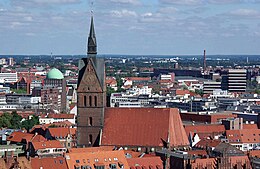Church in Hanover, Germany
| Marktkirche | |
|---|---|
| Marktkirche St. Georgii et Jacobi | |
 Market Church seen from the observation platform of the New Town Hall Market Church seen from the observation platform of the New Town Hall | |
| Market Church and the approximate location of the former 13th-century defensive wall encircling the old town (●) that grew around the church and the market place next to it | |
| 52°22′18″N 9°44′07″E / 52.371789°N 9.735329°E / 52.371789; 9.735329 | |
| Location | Hanover |
| Country | Germany |
| Denomination | Evangelical-Lutheran Church of Hanover |
| Previous denomination | Catholic Church |
| Website | www |
| History | |
| Status |
|
| Dedication | |
| Consecrated | ~ 1360 |
| Architecture | |
| Functional status | Active |
| Architectural type | Hall church |
| Style | Brick Gothic |
| Groundbreaking | 1347 |
| Completed | 1366 (1366) |
| Specifications | |
| Length | 61.5 metres (202 ft) |
| Width | 26.6 metres (87 ft) |
| Nave width | 8 metres (26 ft) centre 5.4 metres (18 ft) lateral |
| Spire height | 97.26 metres (319.1 ft) |
| Materials | Brick |
| Administration | |
| Synod | Evangelical-Lutheran Church of Hanover |
| Deanery | Hanover City (Stadtkirchenverband) |
| Parish | Marktkirchengemeinde, Hanover |
The Market Church (German: Marktkirche, meaning 'church at the market place') is the main Lutheran church in Hanover, Germany. Built in the 14th century, it was referred to in 1342 as the church of Saints James and George (Latin: ecclesia sanctorum Jacobi et Georgii) in dedication to Saint James the Elder and Saint George. Replacing an older, smaller, church at the same location that dated to 1125 and that is known to have been called St. Georgii (after Saint George) in 1238, Hanover grew around it and the market place situated immediately adjacent to its south that was established around the same time. Today the official name of the church is Market Church of Saints George and James (Marktkirche St. Georgii et Jacobi), and along with the nearby Old Town Hall is considered the southernmost example of the northern German brick gothic architectural style (norddeutsche Backsteingotik).
A hall church with a monumental saddleback roof that rises above the nave and two aisles, the roof and the vaults of the naves were restored in 1952 after being destroyed in an air raid in 1943. Its tower, situated on its western side and a symbol of the power and wealth of the citizens of the town when built, is both a landmark of Hanover and, 637 years after its roof was first constructed, one of the highest towers in Lower Saxony.
Altar
The main altar was carved of linden wood around 1480. Its front depicts the Passion of Christ in 21 scenes following models of Martin Schongauer, while its back shows scenes from the lives of the two patron saints, Saint George and Saint James. Moved to the Aegidienkirche in 1663 to make room for a Baroque altar, the altar was taken to the Welfenmuseum in 1856 and thus spared destruction during World War II when the Aegidienkirche was bombed. It was returned to the Market Church in 1952.
Organ
An organ was installed in the tower room (Turmraum) in 1893, which included parts of an instrument of the 17th century. This organ was destroyed in World War II.
Today's main organ is at the back wall of the southern aisle. The first instrument in that location was built in 1953 and 1954 by the organ builders Emil Hammer Orgelbau [de] and Rudolf von Beckerath. It had 61 stops, four manuals and pedal. The casing (Prospekt) was designed by Dieter Oesterlen and is a protected monument.
From 2007 to 2009, the instrument was rebuilt by Orgelbau Goll in Lucerne. The casing and about half of the pipes were kept. The new organ has 64 stops, 39 of them mostly using the older material.
Bells
The Market Church has 11 bells. The Bell of Christ and Peace (Christus- und Friedensglocke) is the biggest in Lower Saxony and is used on special occasions only.
References
- ^ "Baugeschichte". kirche-hannover.de (in German). Archived from the original on 29 September 2011. Retrieved 5 November 2022.
- Wehking, Sabine. "Stadt Hannover, Einleitung, 2. Die Hannoverschen Inschriften – Einordnung in die Stadtgeschichte". Deutsche Inschriften Online (in German). Retrieved 6 November 2022.
- Mlynek, Klaus; Röhrbein, Waldemar R. (eds.). "Chronik der Stadt Hannover von den Anfängen bis 1988 – Tabellarische Darstellung" (PDF). Stadtchronik Hannover (in German). Stadtarchiv Hannover. Retrieved 7 November 2022.
- Karl-Heinz Grotjahn M.A. (2009). "Marktkirche S. Georgii et Jacobi". In Klaus Mlynek; Waldemar R. Röhrbein (eds.). Hannover City Lexicon. From the beginnings into the present (in German). Hanover: Schlütersche Verlagsgesellschaft. pp. 426–427. ISBN 978-3-89993-662-9. OCLC 458691668. OL 45212542M. Wikidata Q2327579.
- "Die Orgeln der Marktkirche" [The pipes of the Market Church] (in German). 30 August 2011. Archived from the original on 30 August 2011. Retrieved 5 November 2022.
- Wubs, Dennis (13 June 2011). Hannover Marktkirche: Glocken der Evangelische Lutherischen Bisschofskirche (Plenum) [Hanover Market Church: Bells of the Evangelical Lutheran Bishop's Church (plenum)]. YouTube. Retrieved 5 November 2022.
External links
- Official website

- Marktkirche Archived 9 January 2015 at the Wayback Machine at MyTravelGuide
- Kurze Kirchengeschichte der Altstadt – short history of the churches in the Old Town, kirche-hannover.de (in German)


